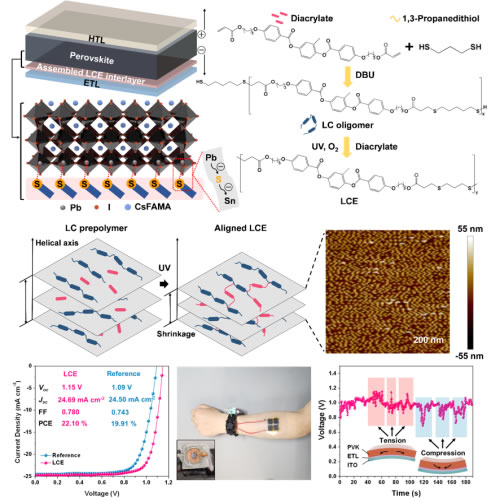Chemical Institute and others make progress in the integration of wearable perovskite solar cells
2025-06-07 13:32:20
Perovskite solar cells have garnered significant interest in photovoltaics because of their impressive energy conversion efficiency, affordability, and ability to be produced at low temperatures. Beyond their efficiency, perovskite solar cells fabricated via low-temperature methods also exhibit great flexibility, portability, and compatibility with curved surfaces, making them ideal candidates for integration with flexible electronics. This opens up possibilities for developing wearable electronic devices and integrating photovoltaics into buildings. However, the reliability of these solar cells is challenged when they undergo mechanical deformation, which can lead to defects and performance losses.
At the Key Laboratory of Green Printing, Institute of Chemistry, Chinese Academy of Sciences, led by Professor Song Yanlin, there has been substantial progress in the integration of flexible, wearable perovskite solar cells. Their work has been published in several prestigious journals, including Advanced Materials (2017, 29, 1703236), Energy & Environmental Science (2019, 12, 979-987), Joule (2019, 3, 2205-2218), ACS Energy Letters (2019, 5, 1065), Nature Communications (2020, 11, 3016), Advanced Energy Materials (2021, 11, 2101291), and Infomat (2022, 4, e1235). By combining green nanoprinting techniques with innovative mechanical design, the team has achieved functional integration of flexible perovskite power systems, laying the groundwork for their use in mobile power supplies and wearable electronics.
Recently, the team introduced a novel approach using liquid crystal elastomers as molecular interlayers within the orientation interface to enhance the order of charge transport channels. This method enabled the creation of stable, wearable perovskite solar cells. The study found that upon photopolymerization of liquid crystal diacrylate monomers and liquid crystal oligomers with dithiol end groups, molecular order is immediately fixed. The organized assembly of the liquid crystal elastomer interlayer increases surface energy and nucleation density, improving the densification of perovskite films. Additionally, the neat arrangement of liquid crystal structures maintains efficient charge collection while minimizing carrier recombination at the SnO2/perovskite interface. Consequently, rigid devices reached efficiencies of up to 23.26%, while flexible ones achieved 22.10%.
The presence of the liquid crystal elastomer interlayer also suppresses phase segregation in the upper perovskite crystal under continuous light, enhancing the operational stability of the solar cells (T80 > 1570 hours). Furthermore, liquid crystal elastomers relieve interface residual stress between the electron transport layer and the perovskite layer through ordered molecular accumulation. The construction of the elastomer interface reduces overall stress distribution across the ITO and perovskite film, ensuring the structural integrity of the entire device. Optimized flexible devices maintained 86% of their initial efficiency even after 5,000 bending cycles. The team further explored integrating this reliable solar cell chip into wearable tactile perception devices to create a pain-sensing system for virtual reality applications.
This research was recently published in Nature Communications (2023, 14, 1204) and was supported by funding from the National Natural Science Foundation of China, the Ministry of Science and Technology, the Beijing National Research Center for Molecular Sciences, and the Chinese Academy of Sciences. The work involved collaboration with the Institute of Chemistry and Jiangxi Normal University.

This breakthrough represents a major step forward in the development of practical wearable solar technologies, with potential applications ranging from smart clothing to advanced building-integrated photovoltaics.
Black Red Milano Tile,Milano Noir Porcelain Tile,Black And Red Tile,Black And Red Tiles
Shandong Yahong New Materials Technology Co., Ltd , https://www.okrooftile.com